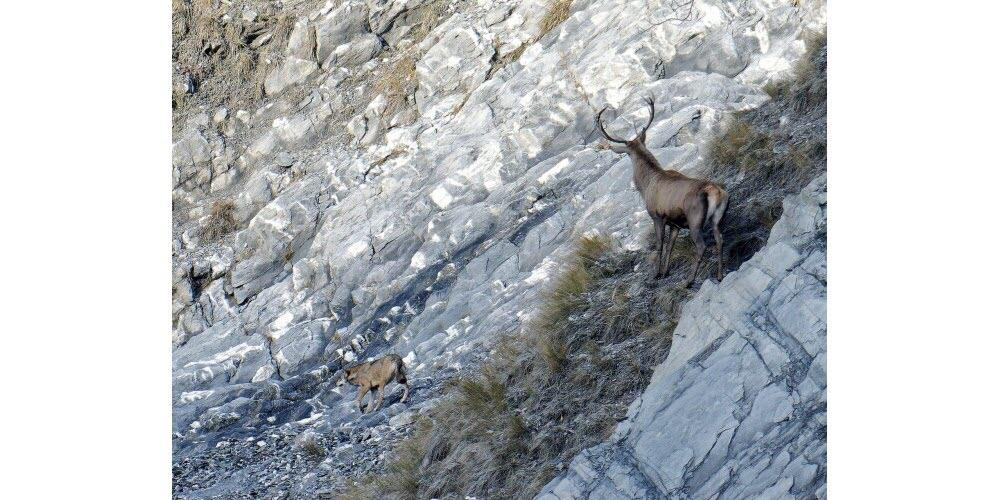It's still common to hear, here and there, that the wolf stresses its prey, that they're no longer peaceful, that its presence is a major disturbance for wildlife. Of course, the numerous studies, observations and reports worldwide, carried out by specialists, biologists and even third parties, show that this ain't the case.
The reappearance of a predator in an environment where it has been absent for years, or even decades, may initially cause a slight drop in prey numbers. Why might this be? Simply because they're no longer used to living alongside a predator other than humans, whom they know for centuries. During the hunt, which in the case of deer and ungulates only takes place over short periods, prey species have learned how to behave, which gives them a chance of escaping the hunt by heading for free-range areas etc. This knowledge, passed down over many generations, is the key to the survival of these species. This knowledge, present over many generations, is passed on not only through the genes (instincts) but also through learning, taught by parents/congenes and lived experience (epigenetics). Prey therefore learns to beware of humans, at certain times of the day or year, and knows where to take refuge, which often complicates the task of hunters. In the Swiss National Park region (Grisons), as soon as the first shot are heard, lots of deer take refuge in the Park, knowing that hunters can't get there. It's a well-known fact.
When a new predator returns, the prey must tame it again, i.e. get to know it (how it works, its behaviour, attitudes, movements, etc.), and this can take quite some time. The wolf will therefore take advantage of its prey's inexperience, and may be a little more successful at first. Then, over the months/years that follow, the prey acquire knowledge that enables them to better apprehend the predator, thus increasing their chances of survival. Thus, through observation and experience, they know how to spot the signs, differentiate the various behaviors (predation, resting, etc.) and thus the degree of risk/danger. They also adopt different techniques, grouping together or, on the contrary, breaking up into smaller groups (herds). Finally, they also change their habits and resting/meal areas, preferring places where they can find refuge and/or see the predator coming, thus further increasing their chances. These changes are altering the situation, particularly in terms of observations and counts, often leading to the mistaken belief that the predator has decimated its prey in places where, in the past, prey was abundant. But the reality is quite different: it's simply a question of necessary changes, of prey adapting to a new element in their environment.
Prey don't undergo stress except at the moment of predation, which is also the case for any living being (human or animal) that is confronted with a danger in his daily life ; we all do. Outside of an attack, prey animals assess the situation, and it's common to see deer, ibex and other animals passing close to the predator, as shown by numerous videos filmed in different parts of the planet. They're also capable of opposing the wolf, charging at it, injuring it and sometimes even killing it. These cases aren't that rare, and are documented in books by wolf specialists who have observed them over the last few decades ("Wolves on the hunt" - Mech/Smith/MacNulty).
Predator and prey share the same territory, except that the wolf's is up to 10x larger. So, by moving constantly, over very long distances and never staying in one place for more than a few days, the wolf doesn't decimate its prey. What's more, the wolf also vary the range of its menus, hunting both hares and deer, as well as all types of prey (furred, feathered or scaled) and sizes. As a result, prey have moments of relative calm, when the predator is in another zone, but are always vigilant. It should be remembered that one of the wolf's advantages over human, in relation to its prey, is that he's all the time present in its territory and hunts there all year round. This means that prey are forced to move around and change their habits, thus preventing them from becoming sedentary. This is the cause of much of the damage they cause to crops and forests, in addition to possible overpopulation.
To show you how prey cohabit with predators without being negatively affected, we show you three videos filmed at the same location. The wild boar passes by, followed by the wolf and then the deer. And all in just 1h15 ! You can also watch videos on the Facebook pages of Pietro Santucci or Raffaele Imondi, which will show you real inter-species interactions in the wild !
Article : TT - Wolf Mission
Videos : Wolf Mission
Photo : Jérémy Voirin

